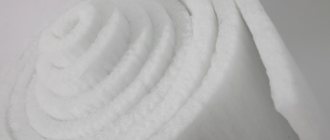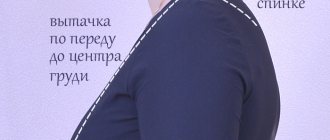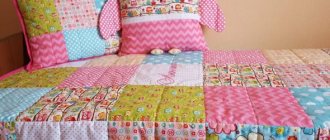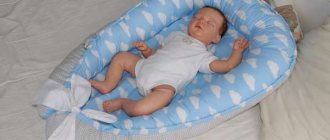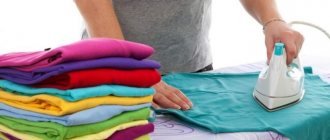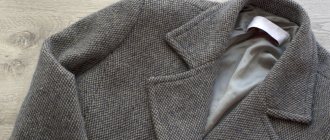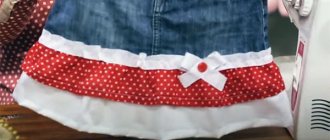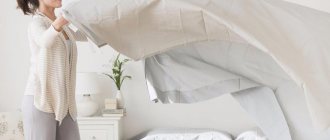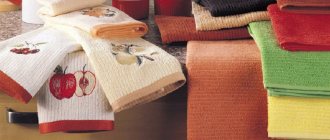A large number of young parents are interested in the question: how to sew children's bedding. Or maybe the best option is to buy baby underwear in a store? To determine which is better, you need to compare the pros and cons of each side. Of course, the price of a complete set of linen is higher than linen purchased separately. However, sewing takes a lot of effort and time, which is already not enough.
The advantage of doing it yourself is that the mother herself will choose the appropriate material of good quality and color, and the process, although it will take some time, is not difficult even for beginners. Today we will look at how to sew a kit for a newborn’s crib with your own hands.
Sewing your own underwear is interesting not only for the mother, but also for the child
Choosing the right fabric
If you make the choice yourself, then you need to consider only high-quality fabric, preferably of natural origin. You should choose only those types of materials that have the following qualities:
- Hypoallergenic;
- Environmental cleanliness;
- Increased comfort;
- Air permeability;
- Easy to wash and care.
The set must meet all quality standards.
The best option is 100% cotton fabric. Bedding made from it is suitable for any season: summer and winter. There are the following classes of cotton fabrics, differing from each other in the type of weaving of the threads:
- Calico. It is hypoallergenic, breathable in both directions and has high wear resistance, but is rougher to the touch than other types and requires proper washing or it will begin to fade;
- Chintz. The material is natural and pleasant to the touch. It is also highly breathable, but unlike calico, it does not require special care. Its disadvantage is rapid wear and loss of brightness (color) over time. Ideal for children immediately after discharge from the hospital;
- Satin. It has excellent wear resistance, does not electrify and does not wrinkle. In addition, satin retains its appearance after repeated washings and transfers heat well. It has no distinctive disadvantages;
- Poplin. Excellent air permeability and evaporation of moisture, easy to wash and does not accumulate static electricity. It has virtually no negative qualities, but can shrink when washed in hot water;
- Bamboo. It has high strength and antimicrobial action. Excellently absorbs moisture and odors. The downside is the high cost;
- Flannel. Soft to the touch and becomes even softer after washing. Quickly retains heat and does not cause allergic reactions. Disadvantage: formation of pellets over time, as well as severe creasing.
You might be interested in this: The procedure for sewing a lining for a dress with your own hands
Cotton is an ideal material for children's underwear
Recommendations for creating a side
In fact, you can use the sides without a cover, but it is better to sew them separately. This way, you can eliminate problems that arise when cleaning the product. And if additional removable covers are put on the sides, then such a cover can be easily washed and put on again.
For covers, it is recommended to use materials with high density. It can be satin, calico or teak. The material and colors are selected depending on the wishes and preferences of the parents themselves.
It is better to take the material that does not require delicate washing, dry cleaning and special care. It should wash off easily. It can be ordinary chintz or fabrics with water-repellent impregnation.
How to make bed linen soft
Why does the bed linen smell musty in the closet?
Sizes and measurements
With measurements of linen everything is simple, as for adults; for children there is a classification of linen into single, single and double. It is sewn in two standards: European and Russian. Children's bedding should be sewn based on their height and their own preferences. In general, the standard defines the following sizes for children:
- Duvet cover - 110 - 120 centimeters by 140-150 centimeters;
- Sheet - 100-120 centimeters by 138-160 centimeters;
- Pillowcases - 40 by 60 centimeters.
Important! A children's set differs from an adult's not only in size, but also sometimes in its contents. One of the features is the presence of elastic bands that secure the sheet to the mattress. This prevents the sheets from becoming wrinkled in the morning and ensures better quality sleep for your baby, who often tosses and turns at night.
size table
Quantity of material
Before you sew a fitted sheet for a nursery, you need to correctly measure the mattress and buy fabric. A product that is too small will slide off, and a product that is too large will clump during sleep.
Before buying fabric, determine the size of the sheet, taking into account the length and width of the mattress, as well as its height.
In order to sew in an elastic band and make a bend under the mattress, it is necessary to provide an additional 20 cm of material. Don't forget that all natural fabrics shrink when washed. The degree of shrinkage depends on the type of material, but on average ranges from 7-11%. Based on this, in order to sew a sheet with an elastic band into a crib with your own hands, you need the following amount of material (for sizes 60x120 cm):
- 120 cm+height+2*20 cm+7% length;
- 60 cm+height+2*20 cm+7% width.
Fabric consumption when sewing
In order to purchase exactly the amount of fabric needed for sewing, and not make a mistake in the sizes, you need to measure each attribute:
- pillow;
- Blanket;
- Mattress;
- Bed.
You can measure the laundry you already have to save even more. You can calculate using standard sizes without running around the house with a ruler using the size numbers indicated in the previous section. You should also take into account that the canvas needs to be purchased 10 or 15 cm more than required. The fabric often “shrinks” and when sewing it may be necessary to make the product a couple of centimeters longer.
An example of cutting children's bedding
We sew bumpers for the crib
This fabric device will help protect your baby from drafts, noise and impacts on the bed bars.
We will need a piece of cotton fabric, filler (sintepon, foam rubber).
Metering
To sew bumpers into a bed for a newborn, we will need fabric 550 cm long and 110 cm wide. The optimal thickness of the filler is about a centimeter. Before cutting out, wash the material, let it dry and iron it thoroughly.
Pattern
We mark the material in accordance with the proposed pattern. Although, in fact, you can measure the crib and immediately mark the measurements taken on the material. We first measure the baby’s crib, because its size may be non-standard.
Sewing
We sew, sewing in the frill at the same time. In this case, we leave one edge of the product unsewn. If desired, you can omit the frill. For the frill, choose a harmonizing color (you can use ribbon) or just take the leftover material for the frill.
Cutting out the filler
We mark the foam rubber (sintepon) with a felt-tip pen or pencil. We cut out the drawn pattern using scissors. Remember: the size of the filler should be slightly smaller than the fabric part, about half a centimeter on each side.
Filling the side
For the convenience of filling the headboard, you do not need to cut the foam rubber exactly to the size of the part; you can cut it vertically into two parts. This will make it easier to insert it into the side, but the cover will need an additional seam.
The sidewall, like the headboard, is best divided into two pieces. It is easier to insert the filling into the side through the bottom unsewn seam than through the narrow side seams. We sew up the bottom seam of the side.
Tip: To make it easier to use, it is better to stitch the bottom seam of the side panel on your hands. Such a seam is easier to rip open in order to change the filling or wash it.
We decorate the sides with ribbons. At the same time, such ribbons will act as ties that will attach the side panel to the rods. To make it easier to mark the places where the ribbons will be sewn, it is recommended to attach the part to the crib and mark these places with chalk. If the crib is not at hand, it is best to attach ribbons in the middle of the side and in the corners.
For convenience, you can sew a couple more separate halves, approximately equal to half of the large sidewall. Such pieces can be placed as a double headboard to create additional protection for a child's head or placed on the side of the crib. Alternatively, you can put them in the chest of drawers, and then use them for changing clothes or swaddling the baby in the crib.
How to sew bedding for a crib with your own hands
Before you start sewing, you need to prepare all the necessary tools:
- Fabric, the width of which will be from one and a half meters with a length of four meters;
- Dense material for sides;
- Thread and needle;
- Sewing machine;
- Scissors and pins;
- Tape and ruler;
- Crayons or remnants;
- Foam rubber and iron.
In addition, you need a good mood and free time. The work done in a hurry will have the appropriate quality.
Cutting is just as important as sewing
Pillowcases
Sewing a pillowcase is simple, but you need to be precise. To do this, you need to fold the pattern and follow the instructions:
- Measure a piece of fabric measuring 70 by 50 cm from the canvas and fold it with the right side inward;
Pillowcase pattern
- The 30 cm corner that remains from cutting should be folded to the top to create a valve that prevents the pillow from falling out of the pillowcase;
- Fold the sides and stitch them first along the front side, and then along the back;
- It is advisable to steam the finished product and iron it.
You may be interested in this: Sewing a beautiful robe without a pattern and sewing
Ready product
sheet
The sheet is made using several methods: with elastic and in the usual way. For the first method, the step-by-step instructions are as follows:
- Cut a piece of fabric and allow an allowance of a couple of centimeters on each side. The result will be a piece 145 in length and 115 in width;
- Fold the fabric over each side once or twice and begin stitching. The processed edges do not look very nice, so they can also be hemmed;
- The product should also be ironed, especially the edges.
Pattern for sewing sheets
The second type of sheets is suitable for active kids. It is more difficult to sew, but following the instructions, everything will work out:
- Cut the fabric 120 by 150 cm;
- Fold it four times and measure a 20 by 20 square in the upper right corner;
- Cut it off with scissors, and then stitch the corners and turn them over;
- Hem all sides, taking into account space for the elastic, which will be threaded later;
- Insert the elastic into the sheet and stretch it all the way around, then hem it.
Important! The fitted sheet should fit tightly, but not tightly, onto the mattress so that it cannot be brushed off by simply turning the body. If it does not fit, then you need to replace the elastic band with a longer one or, conversely, hem it if the sheet falls off.
Bed sheet with elastic band
Duvet cover
To make it, you need a piece measuring 210 by 290 cm. You should immediately try it on the blanket and make sure that it fits there. The next steps are:
- Fold the fabric in half and work the top and bottom;
- 40–50 cm of fabric are left on the sides for a hole for inserting a blanket;
- Cover the hole with tape or treat it as desired;
- Iron the product and straighten all corners and seams.
Ready-made duvet cover, sewn yourself
Bumpers for the crib
The bumpers are a useful thing that can protect children from hitting the bed rods. To make them, you need thicker fabric, which you need to buy separately. You can make it as follows:
- Make a pattern for rectangular sides. Fabrics are cut 40 by 60 along the length of the bed, 40 by 120 along the width;
- Finish the edges by sewing braid or ribbons to them to tie them to the beds;
- Turn the sides inside out and fill them with foam rubber for softness;
- Sew a zipper into each product to remove the foam when washing;
- Lay out and strengthen the sides along the bed.
You might be interested in How to sew a pleated skirt
Bumpers on the crib
Sewing a sheet
Once all the fabric is cut, determine the sequence of steps. It is best to start with a sheet - this is the simplest product in your case. Although, if you sew it with an elastic band, then sewing will not be so easy!
For the simplest option, you will need a regular rectangle; you will need to bend the edges. Make 2 folds of half a centimeter and sew a seam using a machine.
The second option is much more complex, requiring some calculations and a different pattern. However, it is worth it, and later you will be glad more than once that you were not lazy.
This sheet requires more material than a regular one. Add allowances for the fit of the mattress (11 - 12 cm), for the seams (1.5 - 2 cm) and for the elastic drawstring. It should be approximately 165*115 cm. The fabric is sewn along the dotted lines in the corners, then it is folded and a drawstring is sewn along the edge, leaving a hole for the elastic (its length will be equal to half the perimeter of the mattress). We got a sheet with an elastic band.
How to decorate a baby bedding set
The finished set can also be decorated. In this matter, everyone must show imagination and care. You should also take into account that there is a child lying in the bed, and he can put a decorative element in his mouth, which can be dangerous.
The set can be decorated with embroidered lace, frills, ruffles, and wide ribbons. It is strictly not recommended to use buttons, zippers, rhinestones and beads. They may fall off or be torn off and the child will swallow them out of curiosity.
Decorating pillowcases with lace
Ready-made kits – what to look for?
When choosing a ready-made kit, it is recommended to give preference to trusted companies that produce specialized products for children. Such products are not cheap, but the costs are recouped by the quality of the products and a long service life.
You should not buy underwear made in China . Such products cost much less, but contain components that are harmful to the child’s health: chemical dyes, synthetic additives. They tear quickly and fade intensely when washed.
The bed rails must be securely fixed to the railing, otherwise they will fall out. The blanket and pillow should be easy to wash along with linen, so it is advisable to have several sets.
You will need to change your underwear up to several times a week, daily if necessary. You will also need a large number of absorbent diapers.
The linen should not slip, twist or form lumps - this happens if the size was chosen incorrectly. In this case, you will have to change the kit.
Helpful tips for completing your work
When the set is ready, you need to wash it thoroughly again, dry it and iron it, and see if the linen has shrunk. After this, you can safely tuck the pillows into the pillowcases and the blanket into the duvet cover. If you liked the process, then you can make several sets for a crib and change them one by one. Each of them can be decorated with its own elements.
Important! Before use, you should carefully check again to see if there are any needles or pins left in the fabric. This is quite possible and sooner or later the child will get hurt or even cause irreparable harm to his health.
To prevent your child from getting hurt, you need to check everything carefully.
Making a duvet cover
To create it, take pre-cut fabric. But if you couldn’t do it using our patterns, just transfer your measurements to the fabric laid in two layers and cut it out. Don't forget the seam allowances - approximately 1.5-2 cm. Now fold the fabric in half (right side in) and sew all the necessary seams. You can sew with a closed seam, or you can immediately install a zig-zag stitch on the machine.
The main thing is that if you get carried away with your work, do not close the gap for inserting the blanket. The length of this hole is usually 45 - 50 cm, and do not forget to carefully bend the edges inward.
Turn the duvet cover right side out and straighten out the corners. The second part of the kit is ready!
Beautiful children's bedding sets for inspiration
Here is a selection of beautiful children's bedding that will help you catch inspiration and understand what exactly you want to make, from what fabric and how to decorate it later.
Set with dinosaurs
Thus, sewing children's bedding is easy and exciting even for beginner seamstresses, not to mention masters of their craft. By choosing the material yourself and doing the sewing, you can not only save money, but also bring pleasure to yourself and your baby.
Preparation
Before cutting the fabric, it is necessary to decate it. Decatting is the forced shrinkage of fabric. It often happens that after washing, your favorite item becomes small and shrinks. The reason for this is the shrinkage of the fibers of the fabric.
Therefore, after purchasing the fabric, you need to soak it in cold water, dry it and iron it with a hot iron. You can do it simpler: just use an iron with a steam generator. This is especially necessary for those canvases based on natural raw materials. In our case, this is exactly what bed linen is made from: cotton, linen, satin, etc.
